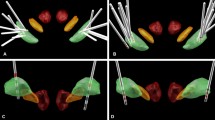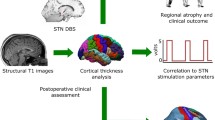Abstract
Purpose
The purpose of the present study is to investigate the effect of deep brain stimulation (DBS) on regional cerebral blood flow (rCBF) in cases of secondary dystonia as well as to correlate the rCBF changes with clinical outcomes.
Methods
Six patients with medically intractable secondary dystonia who underwent DBS surgery were included in this study. Burke–Fahn–Mardsen Dystonia Rating Scale (BFMDRS) was used for the assessment of dystonia, before and after surgery. Single photon emission computed tomography (SPECT) of the brain was performed postoperatively in the two stimulation states (ON-DBS and OFF-DBS) and the changes of rCBF in the three following brain regions of interest (ROIs): primary motor cortex, premotor and supplementary motor cortex, and prefrontal cortex were evaluated.
Results
Two patients exhibited excellent response to DBS, two patients got moderate benefit after the procedure, and in two patients, no clinical improvement was achieved. A mean improvement of 49.1% (0–90.7%) in BFMDRS total scores was found postoperatively. Brain SPECT data analysis revealed an overall decrease in rCBF in the investigated ROIs, during the ON-DBS state. Clinical improvement was significantly correlated with the observed decrease in rCBF in the presence of DBS.
Conclusions
When conservative treatment fails to relieve severely disabled patients suffering from secondary dystonia, DBS may be a promising therapeutic alternative. Moreover, this study indicates a putative role of brain SPECT imaging as a postoperative indicator of clinical responsiveness to DBS.




Similar content being viewed by others
References
Albanese A, Barnes MP, Bhatia KP, Fernandez-Alvarez E, Filippini G, Gasser T, Krauss JK, Newton A, Rektor I, Savoiardo M, Valls-Sole J (2006) A systematic review on the diagnosis and treatment of primary (idiopathic) dystonia and dystonia plus syndromes: report of an EFNS/MDS-ES Task Force. Eur J Neurol 13:433–444
Asanuma K, Carbon-Correll M, Eidelberg D (2005) Neuroimaging in human dystonia. J Med Invest 52(Suppl):272–279
Bhatia KP, Marsden CD (1994) The behavioural and motor consequences of focal lesions of the basal ganglia in man. Brain 117(Pt 4):859–876
Bhidayasiri R (2006) Dystonia: genetics and treatment update. Neurologist 12:74–85
Ceballos-Baumann AO, Passingham RE, Warner T, Playford ED, Marsden CD, Brooks DJ (1995) Overactive prefrontal and underactive motor cortical areas in idiopathic dystonia. Ann Neurol 37:363–372
Chen CC, Kuhn AA, Trottenberg T, Kupsch A, Schneider GH, Brown P (2006) Neuronal activity in globus pallidus interna can be synchronized to local field potential activity over 3-12 Hz in patients with dystonia. Exp Neurol 202:480–486
Cif L, El Fertit H, Vayssiere N, Hemm S, Hardouin E, Gannau A, Tuffery S, Coubes P (2003) Treatment of dystonic syndromes by chronic electrical stimulation of the internal globus pallidus. J Neurosurg Sci 47:52–55
Constantoyannis C, Kagadis GC, Ellul J, Kefalopoulou Z, Chroni E (2008) Nucleus ventralis oralis deep brain stimulation in postanoxic dystonia. Mov Disord 24:306–308
Coubes P, Cif L, El Fertit H, Hemm S, Vayssiere N, Serrat S, Picot MC, Tuffery S, Claustres M, Echenne B, Frerebeau P (2004) Electrical stimulation of the globus pallidus internus in patients with primary generalized dystonia: long-term results. J Neurosurg 101:189–194
Detante O, Vercueil L, Thobois S, Broussolle E, Costes N, Lavenne F, Chabardes S, Lebars D, Vidailhet M, Benabid AL, Pollak P (2004) Globus pallidus internus stimulation in primary generalized dystonia: a H215O PET study. Brain 127:1899–1908
Eidelberg D, Moeller JR, Antonini A, Kazumata K, Nakamura T, Dhawan V, Spetsieris P, deLeon D, Bressman SB, Fahn S (1998) Functional brain networks in DYT1 dystonia. Ann Neurol 44:303–312
Eltahawy HA, Saint-Cyr J, Giladi N, Lang AE, Lozano AM (2004) Primary dystonia is more responsive than secondary dystonia to pallidal interventions: outcome after pallidotomy or pallidal deep brain stimulation. Neurosurgery 54:613–619, discussion 619-621
Fahn S, Bressman SB, Marsden CD (1998) Classification of dystonia. Adv Neurol 78:1–10
Gsell W, De Sadeleer C, Marchalant Y, MacKenzie ET, Schumann P, Dauphin F (2000) The use of cerebral blood flow as an index of neuronal activity in functional neuroimaging: experimental and pathophysiological considerations. J Chem Neuroanat 20:215–224
Hallett M (2006) Pathophysiology of dystonia. J Neural Transm 94:485–488
Hartmann A, Pogarell O, Oertel WH (1998) Secondary dystonias. J Neurol 245:511–518
Jinnah HA, Hess EJ (2006) A new twist on the anatomy of dystonia: the basal ganglia and the cerebellum? Neurology 67:1740–1741
Katsakiori P, Kefalopoulou Z, Markaki E, Paschali A, Ellul J, Chroni E, Constantoyannis C (2009) DBS for secondary dystonia. Results on 8 patients. Acta Neurochir 151:473–478
Krauss JK, Loher TJ, Weigel R, Capelle HH, Weber S, Burgunder JM (2003) Chronic stimulation of the globus pallidus internus for treatment of non-dYT1 generalized dystonia and choreoathetosis: 2-year follow up. J Neurosurg 98:785–792
Kumar R, Dagher A, Hutchison WD, Lang AE, Lozano AM (1999) Globus pallidus deep brain stimulation for generalized dystonia: clinical and PET investigation. Neurology 53:871–874
Kupsch A, Benecke R, Muller J, Trottenberg T, Schneider GH, Poewe W, Eisner W, Wolters A, Muller JU, Deuschl G, Pinsker MO, Skogseid IM, Roeste GK, Vollmer-Haase J, Brentrup A, Krause M, Tronnier V, Schnitzler A, Voges J, Nikkhah G, Vesper J, Naumann M, Volkmann J (2006) Pallidal deep-brain stimulation in primary generalized or segmental dystonia. N Engl J Med 355:1978–1990
Kupsch A, Kuehn A, Klaffke S, Meissner W, Harnack D, Winter C, Haelbig TD, Kivi A, Arnold G, Einhaupl KM, Schneider GH, Trottenberg T (2003) Deep brain stimulation in dystonia. J Neurol 250(Suppl 1):I47–I52
Liu X, Yianni J, Wang S, Bain PG, Stein JF, Aziz TZ (2006) Different mechanisms may generate sustained hypertonic and rhythmic bursting muscle activity in idiopathic dystonia. Exp Neurol 198:204–213
Marsden CD, Obeso JA, Zarranz JJ, Lang AE (1985) The anatomical basis of symptomatic hemidystonia. Brain 108(Pt 2):463–483
Meunier S, Lehericy S, Garnero L, Vidailhet M (2003) Dystonia: lessons from brain mapping. Neuroscientist 9:76–81
Mueller J, Skogseid IM, Benecke R, Kupsch A, Trottenberg T, Poewe W, Schneider GH, Eisner W, Wolters A, Muller JU, Deuschl G, Pinsker MO, Roeste GK, Vollmer-Haase J, Brentrup A, Krause M, Tronnier V, Schnitzler A, Voges J, Nikkhah G, Vesper J, Naumann M, Volkmann J (2008) Pallidal deep brain stimulation improves quality of life in segmental and generalized dystonia: results from a prospective, randomized sham-controlled trial. Mov Disord 23:131–134
Ostrem JL, Starr PA (2008) Treatment of dystonia with deep brain stimulation. Neurotherapeutics 5:320–330
Playford ED, Passingham RE, Marsden CD, Brooks DJ (1998) Increased activation of frontal areas during arm movement in idiopathic torsion dystonia. Mov Disord 13:309–318
Pralong E, Pollo C, Villemure JG, Debatisse D (2007) Opposite effects of internal globus pallidus stimulation on pallidal neurones activity. Mov Disord 22:1879–1884
Pretto TE, Dalvi A, Kang UJ, Penn RD (2008) A prospective blinded evaluation of deep brain stimulation for the treatment of secondary dystonia and primary torticollis syndromes. J Neurosurg 109:405–409
Schaltenbrand G, Wahren A (1982) Stereotaxic atlas of the human brain. Thieme, New York
Thobois S, Ballanger B, Xie-Brustolin J, Damier P, Durif F, Azulay JP, Derost P, Witjas T, Raoul S, Le Bars D, Broussolle E (2008) Globus pallidus stimulation reduces frontal hyperactivity in tardive dystonia. J Cereb Blood Flow Metab 28:1127–1138
Tisch S, Rothwell JC, Limousin P, Hariz MI, Corcos DM (2007) The physiological effects of pallidal deep brain stimulation in dystonia. IEEE Trans Neural Syst Rehabil Eng 15:166–172
Vercueil L, Pollak P, Fraix V, Caputo E, Moro E, Benazzouz A, Xie J, Koudsie A, Benabid AL (2001) Deep brain stimulation in the treatment of severe dystonia. J Neurol 248:695–700
Vidailhet M, Vercueil L, Houeto JL, Krystkowiak P, Benabid AL, Cornu P, Lagrange C, Tezenas du Montcel S, Dormont D, Grand S, Blond S, Detante O, Pillon B, Ardouin C, Agid Y, Destee A, Pollak P (2005) Bilateral deep-brain stimulation of the globus pallidus in primary generalized dystonia. N Engl J Med 352:459–467
Vitek JL (2002) Pathophysiology of dystonia: a neuronal model. Mov Disord 17(Suppl 3):S49–S62
Zhang JG, Zhang K, Wang ZC, Ge M, Ma Y (2006) Deep brain stimulation in the treatment of secondary dystonia. Chin Med J (Engl) 119:2069–2074
Author information
Authors and Affiliations
Corresponding author
Additional information
Kefalopoulou et al. are reporting a short retrospective study of six deep brain stimulation (Gpi or Voa) for secondary dystonia with special attention to postoperative blood flow changes (no SPECT done preoperatively). The small size and heterogeneity of this population (different etiologies and different targets) is turning out here to be a major methodological limit. One of the major difficulties in the management of this group of patients is related to the heterogeneity of the etiologies and clinical patterns. The result is rarely partial and very much variable depending on the primary endpoint chosen. This should be of special interest to have postoperatively an objective imaging method allowing to demonstrate that the stimulation is inducing the intended neurobiological effect whether the clinical benefit is obtained or not! This may be especially helpful in those patients with a disappointing result by differentiating the stereotactic failures to activate the system and the failures to specify the disease itself. Additionally, this may contribute to a better understanding of the mechanism of effect of the DBS in secondary dystonia. However, only larger series of patients with more consistent etiology and surgical procedures will allow such contribution.
Jean Regis
France
Rights and permissions
About this article
Cite this article
Kefalopoulou, Z., Paschali, A., Markaki, E. et al. Regional cerebral blood flow changes induced by deep brain stimulation in secondary dystonia. Acta Neurochir 152, 1007–1014 (2010). https://doi.org/10.1007/s00701-010-0612-y
Received:
Accepted:
Published:
Issue Date:
DOI: https://doi.org/10.1007/s00701-010-0612-y




